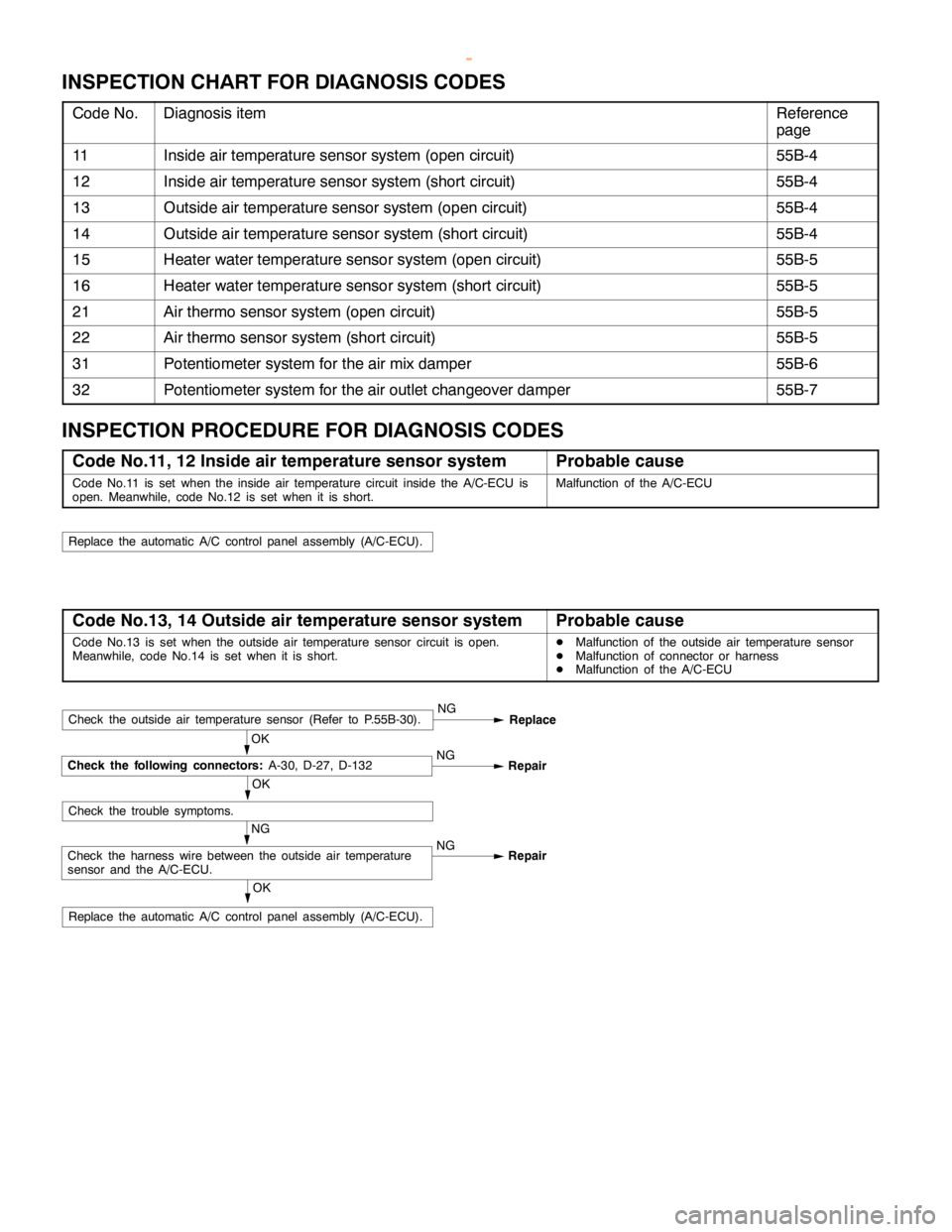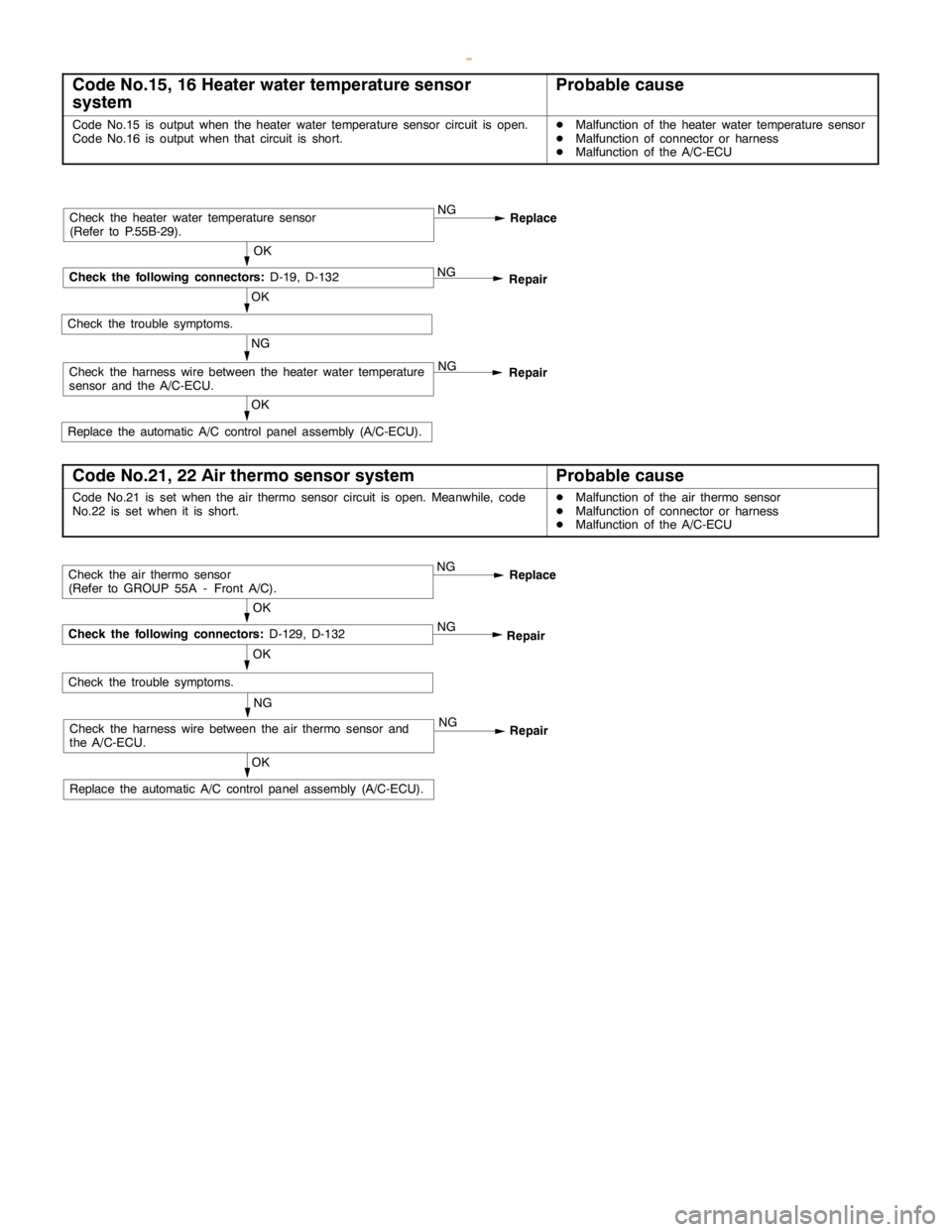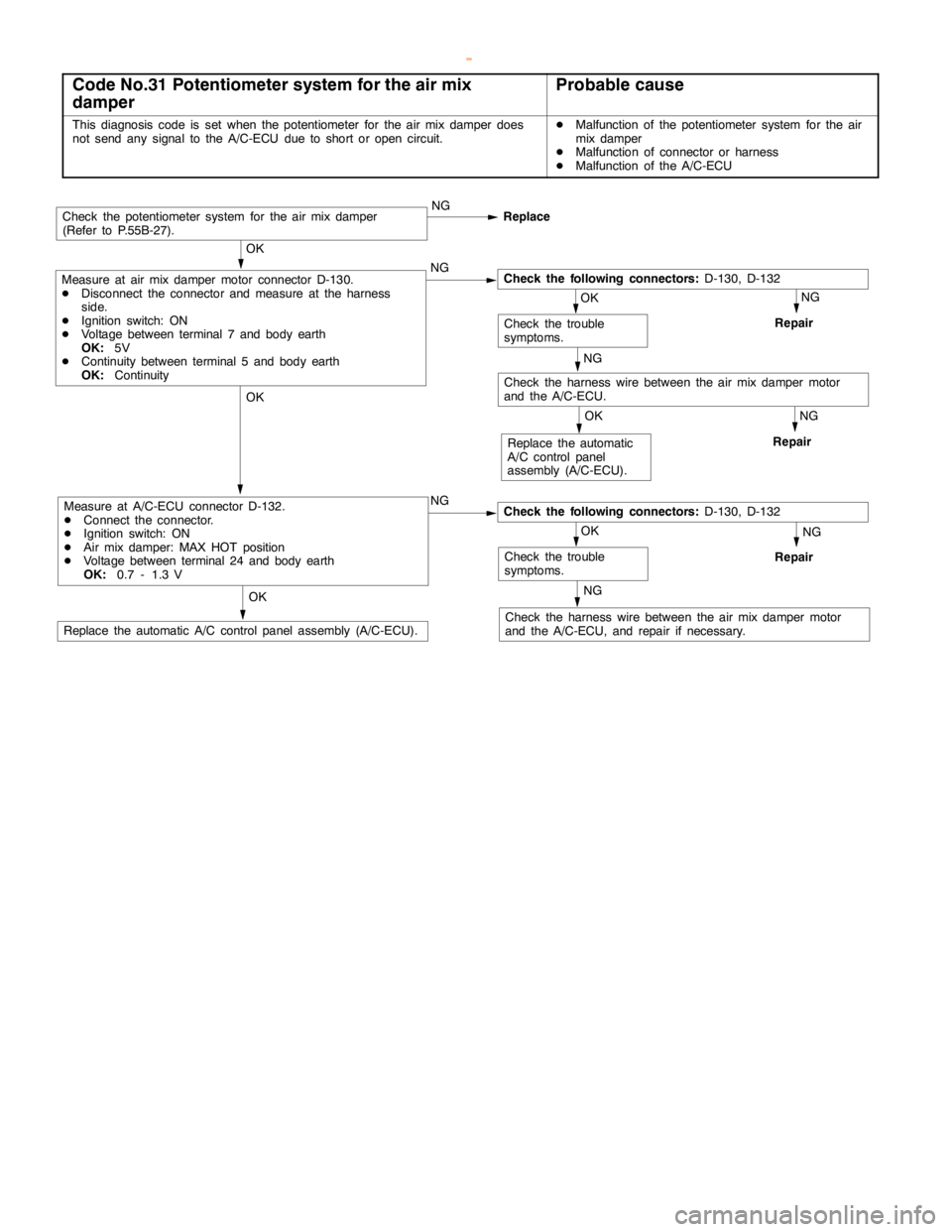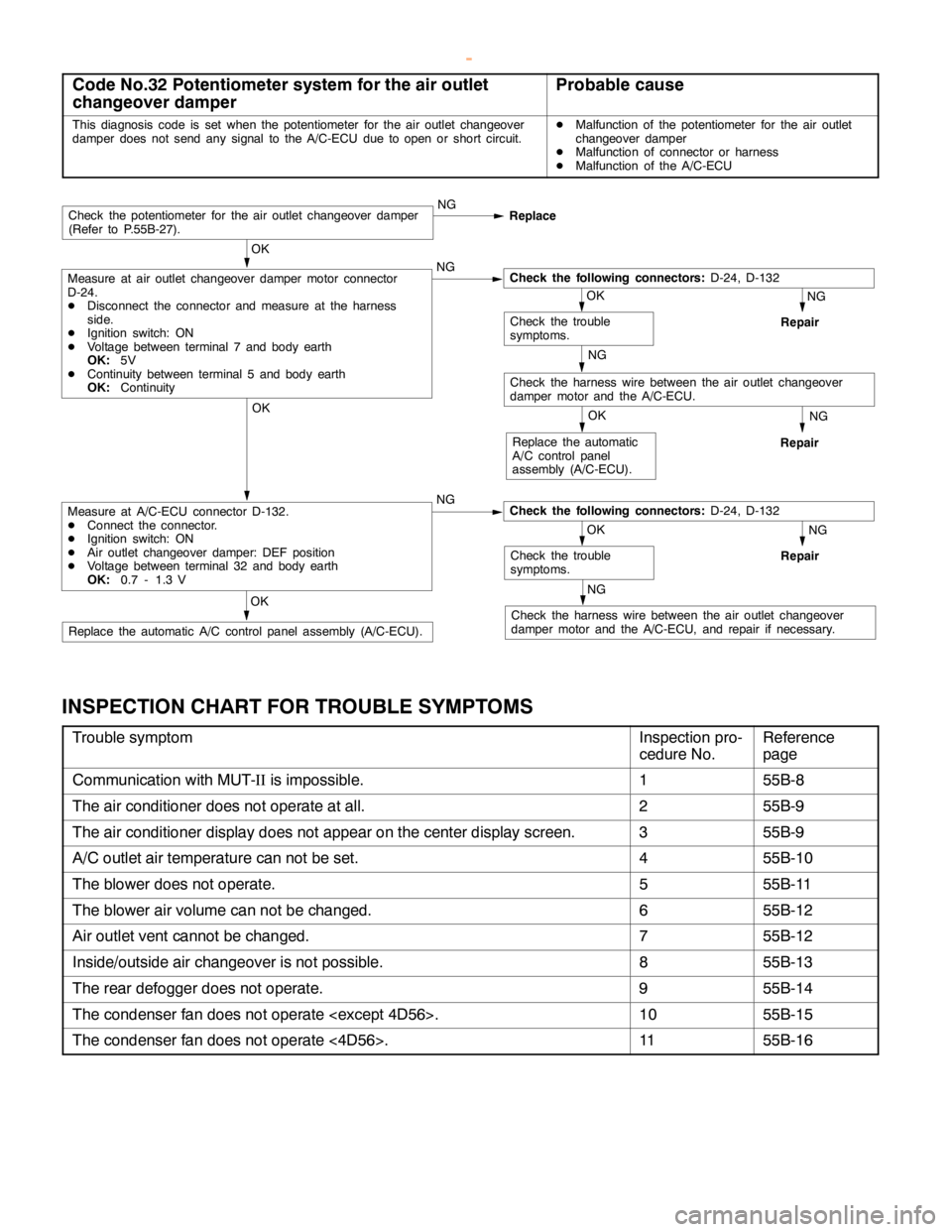2000 MITSUBISHI MONTERO heater
[x] Cancel search: heaterPage 1763 of 1839

HEATER, AIR CONDITIONER AND VENTILATION - On-vehicle Service55A-17
REFRIGERANT LEAK REPAIR
LOST CHARGE
If the system has lost all charge due to a leak:
1. Evacuate the system. (See procedure.)
2. Charge the system with approximately one
pound of refrigerant.
3. Check for leaks.
4. Discharge the system.
5. Repair leaks.
6. Replace receiver drier.
Caution
Replacement filter-drier units must be
sealed while in storage. The drier used in
these units will saturate water quickly upon
exposure to the atmosphere. When
installing a drier, have all tools and supplies
ready for quick reassembly to avoid keeping
the system open any longer than necessary.
7. Evacuate and charge system.
LOW CHARGE
If the system has not lost all of its refrigerant charge;
locate and repair all leaks. If it is necessary to
increase the system pressure to find the leak
(because of an especially low charge) add
refrigerant. If it is possible to repair the leak without
discharging the refrigerant system, use the
procedure for correcting low refrigerant level.HANDLING TUBING AND FITTINGS
Kinks in the refrigerant tubing or sharp bends in
the refrigerant hose lines will greatly reduce the
capacity of the entire system. High pressures are
produced in the system when it is operating.
Extreme care must be exercised to make sure that
all connections are pressure tight. Dirt and moisture
can enter the system when it is opened for repair
or replacement of lines or components. The
following precautions must be observed. The
system must be completely discharged before
opening any fitting of connection in the refrigeration
system. Open fittings with caution even after the
system has been discharged. If any pressure is
noticed as a fitting is loosened, allow trapped
pressure to bleed off very slowly.
Never attempt to rebend formed lines to fit. Use
the correct line for the installation you are servicing.
A good rule for the flexible hose lines is keep the
radius of all bends at least 10 times the diameter
of the hose.
Sharper bends will reduce the flow of refrigerant.
The flexible hose lines should be routed so that
they are at least 80 mm from the exhaust manifold.
It is good practice to inspect all flexible hose lines
at least once a year to make sure they are in good
condition and properly routed.
Unified plumbing connections with O-rings, these
O-rings are not reusable.
COMPRESSOR NOISE
You must first know the conditions when the noise
occurs. These conditions are: weather, vehicle
speed, in gear or neutral, engine temperature or
any other special conditions.
Noises that develop during A/C operation can often
be misleading. For example: what sounds like a
failed front bearing or connecting rod, may be
caused by loose bolts, nuts, mounting brackets,
or a loose clutch assembly. Verify accessory drive
belt tension (power steering or alternator).
Improper accessory drive belt tension can cause
a misleading noise when the compressor is
engaged and little or no noise when the compressor
is disengaged.
Drive belts are speed-sensitive. That is, at different
engine speeds, and depending upon belt tension,
belts can develop unusual noises that are often
mistaken for mechanical problems within the
compressor.ADJUSTMENT
1. Select a quiet area for testing. Duplicate
conditions as much as possible. Switch
compressor on and off several times to clearly
identify compressor noise. To duplicate high
ambient conditions (high head pressure),
restrict air flow through condenser. Install
manifold gauge set to make sure discharge
pressure doesn’t exceed 2,070 kPa.
2. Tighten all compressor mounting bolts, clutch
mounting bolt, and compressor drive belt.
Check to assure clutch coil is tight (no rotation
or wobble).
3. Check refrigerant hoses for rubbing or
interference that can cause unusual noises.
4. Check refrigerant charge. (See “Charging
System”.)
5. Recheck compressor noise as in Step 1.
6. If noise still exists, loosen compressor mounting
bolts and retorque. Repeat Step 1.
7. If noise continues, replace compressor and
repeat Step 1.
www.WorkshopManuals.co.uk
Purchased from www.WorkshopManuals.co.uk
Page 1803 of 1839

HEATER, AIR
CONDITIONER AND
VENTILATION
Click on the applicable bookmark to selected the required model year.
www.WorkshopManuals.co.uk
Purchased from www.WorkshopManuals.co.uk
Page 1804 of 1839

55B-1
HEATER, AIR
CONDITIONER AND
VENTILATION
CONTENTS
SERVICE SPECIFICATIONS 2.................
LUBRICANTS 2..............................
SPECIAL TOOLS 3...........................
TROUBLESHOOTING
TROUBLESHOOTING
ON-VEHICLE SERVICE 24...................
Magnetic Clutch Test 24.........................
Idle Up Operation Check
FRONT A/C 25..............................
Automatic A/C Control Panel Assembly
(A/C-ECU) 25..................................Blower Linear Controller 26......................
Air Mix Damper Motor and
Air Outlet Changeover Damper Motor 27..........
Heater Water Temperature Sensor 29.............
PHOTO SENSOR 30........................
OUTSIDE AIR TEMPERATURE SENSOR 30..
REAR A/C 30...............................
Electric Motor for Air Outlet Changeover
Damper 30....................................
REFRIGERANT LINE 31.....................
COMPRESSOR 33...........................
www.WorkshopManuals.co.uk
Purchased from www.WorkshopManuals.co.uk
Page 1805 of 1839

HEATER, AIR CONDITIONER AND VENTILATION -Service Specifications/Lubricants55B-2
SERVICE SPECIFICATIONS
ItemStandard value
Resistance value of the potentiometer for the air mix damper (front A/C) kWApprox. 0.96 - 5.76
Resistance value of the potentiometer for the air outlet changeover damper (front A/C)
kWApprox. 0.96 - 5.76
Resistance of the rear air conditioner switch (temperature control switch)
Resistance of the potentiometer for the air mix damper
Resistance value of the resistor (rear A/C)Between terminals 1 and 64.9±7%
WBetween terminals 1 and 31.25±7%
Air compressor air gap mm0.35 - 0.65
Idle speed r/min (N or P range)Petrol600±50
Idle-up speed r/min (N or P range)PetrolWhen the A/C is under
low load700±50
When the A/C is under
medium load800±50
When the A/C is under
high load1,000±50
LUBRICANTS
ItemBrandQuantity
Compressor oil mlSingle A/C
Single air conditioner
Pipe connectionsDENSO OIL 8As required
Refrigerant gSingle A/C
Single air conditioner
www.WorkshopManuals.co.uk
Purchased from www.WorkshopManuals.co.uk
Page 1807 of 1839

HEATER, AIR CONDITIONER AND VENTILATION -Troubleshooting
INSPECTION CHART FOR DIAGNOSIS CODES
Code No.Diagnosis itemReference
page
11Inside air temperature sensor system (open circuit)55B-4
12Inside air temperature sensor system (short circuit)55B-4
13Outside air temperature sensor system (open circuit)55B-4
14Outside air temperature sensor system (short circuit)55B-4
15Heater water temperature sensor system (open circuit)55B-5
16Heater water temperature sensor system (short circuit)55B-5
21Air thermo sensor system (open circuit)55B-5
22Air thermo sensor system (short circuit)55B-5
31Potentiometer system for the air mix damper55B-6
32Potentiometer system for the air outlet changeover damper55B-7
INSPECTION PROCEDURE FOR DIAGNOSIS CODES
Code No.11, 12 Inside air temperature sensor systemProbable cause
Code No.11 is set when the inside air temperature circuit inside the A/C-ECU is
open. Meanwhile, code No.12 is set when it is short.Malfunction of the A/C-ECU
Replace the automatic A/C control panelassembly (A/C-ECU).
Code No.13, 14 Outside air temperature sensor systemProbable cause
Code No.13 is set when the outside air temperature sensor circuit is open.
Meanwhile, code No.14 is set when it is short.DMalfunction of the outside air temperature sensor
DMalfunction of connector or harness
DMalfunction of the A/C-ECU
OK
Replace the automatic A/C control panelassembly (A/C-ECU).
NG
Check the harness wire between the outside air temperature
sensor and the A/C-ECU.NG
Repair
OK
Check the trouble symptoms.
OK
Check the following connectors:A-30, D-27, D-132NG
Repair
Check the outside air temperature sensor (Refer to P.55B-30).NG
Replace
www.WorkshopManuals.co.uk
Purchased from www.WorkshopManuals.co.uk
Page 1808 of 1839

HEATER, AIR CONDITIONER AND VENTILATION -Troubleshooting
Code No.15, 16 Heater water temperature sensor
systemProbable cause
Code No.15 is output when the heater water temperature sensor circuit is open.
Code No.16 is output when that circuit is short.DMalfunction of the heater water temperature sensor
DMalfunction of connector or harness
DMalfunction of the A/C-ECU
OK
Replace the automatic A/C control panelassembly (A/C-ECU).
NG
Check the harness wire between the heater water temperature
sensor and the A/C-ECU.NG
Repair
OK
Check the trouble symptoms.
OK
Check the following connectors:D-19, D-132NG
Repair
Check the heater water temperature sensor
(Refer to P.55B-29).NG
Replace
Code No.21, 22 Air thermo sensor systemProbable cause
Code No.21 is set when the air thermo sensor circuit is open. Meanwhile, code
No.22 is set when it is short.DMalfunction of the air thermo sensor
DMalfunction of connector or harness
DMalfunction of the A/C-ECU
OK
Replace the automatic A/C control panelassembly (A/C-ECU).
NG
Check the harness wire between the air thermo sensor and
the A/C-ECU.NG
Repair
OK
Check the trouble symptoms.
OK
Check the following connectors:D-129, D-132NG
Repair
Check the air thermo sensor
(Refer to GROUP 55A - Front A/C).NG
Replace
www.WorkshopManuals.co.uk
Purchased from www.WorkshopManuals.co.uk
Page 1809 of 1839

HEATER, AIR CONDITIONER AND VENTILATION -Troubleshooting
Code No.31 Potentiometer system for the air mix
damperProbable cause
This diagnosis code is set when the potentiometer for the air mix damper does
not send any signal to the A/C-ECU due to short oropencircuit.DMalfunction of the potentiometer system for the air
mix damper
DMalfunction of connector or harness
DMalfunction of the A/C-ECU
NG
Repair
NG
Repair
NG
Check the harness wire between the air mix damper motor
and the A/C-ECU, and repair if necessary.
OK
Replace the automatic A/C control panelassembly (A/C-ECU).
NG
Repair
OK
Replace the automatic
A/C control panel
assembly (A/C-ECU).
OK
Check the trouble
symptoms.
OK
Measure at A/C-ECU connector D-132.
DConnect the connector.
DIgnition switch: ON
DAir mix damper: MAX HOT position
DVoltage between terminal 24 and body earth
OK:0.7 - 1.3 VNGCheck the following connectors:D-130, D-132
NG
Check the harness wire between the air mix damper motor
and the A/C-ECU.
OK
Check the trouble
symptoms.
OK
Measure at air mix damper motor connector D-130.
DDisconnect the connector and measure at the harness
side.
DIgnition switch: ON
DVoltage between terminal 7 and body earth
OK:5V
DContinuity between terminal 5 and body earth
OK:ContinuityNGCheck the following connectors:D-130, D-132
Check the potentiometer system for the air mix damper
(Refer to P.55B-27).NG
Replace
www.WorkshopManuals.co.uk
Purchased from www.WorkshopManuals.co.uk
Page 1810 of 1839

HEATER, AIR CONDITIONER AND VENTILATION -Troubleshooting
Code No.32 Potentiometer system for the air outlet
changeover damperProbable cause
This diagnosis code is set when the potentiometer for the air outlet changeover
damper does not send any signal to the A/C-ECU due toopen orshort circuit.DMalfunction of the potentiometer for the air outlet
changeover damper
DMalfunction of connector or harness
DMalfunction of the A/C-ECU
NG
Repair
NG
Repair
NG
Check the harness wire between the air outlet changeover
damper motor and the A/C-ECU, and repair if necessary.OK
Replace the automatic A/C control panelassembly (A/C-ECU).
NG
Repair
OK
Replace the automatic
A/C control panel
assembly (A/C-ECU).
OK
Check the trouble
symptoms.
OK
Measure at A/C-ECU connector D-132.
DConnect the connector.
DIgnition switch: ON
DAir outlet changeover damper: DEF position
DVoltage between terminal 32 and body earth
OK:0.7 - 1.3 VNGCheck the following connectors:D-24, D-132
NG
Check the harness wire between the air outlet changeover
damper motor and the A/C-ECU.
OK
Check the trouble
symptoms.
OK
Measure at air outlet changeover damper motor connector
D-24.
DDisconnect the connector and measure at the harness
side.
DIgnition switch: ON
DVoltage between terminal 7 and body earth
OK:5V
DContinuity between terminal 5 and body earth
OK:ContinuityNGCheck the following connectors:D-24, D-132
Check the potentiometer for the air outlet changeover damper
(Refer to P.55B-27).NG
Replace
INSPECTION CHART FOR TROUBLE SYMPTOMS
Trouble symptomInspection pro-
cedure No.Reference
page
Communication with MUT-IIis impossible.155B-8
The air conditioner does not operate at all.255B-9
The air conditioner display does not appear on the center display screen.355B-9
A/C outlet air temperature can not be set.455B-10
The blower does not operate.555B-11
The blower air volume can not be changed.655B-12
Air outlet vent cannot be changed.755B-12
Inside/outside air changeover is not possible.855B-13
The rear defogger does not operate.955B-14
The condenser fan does not operate
The condenser fan does not operate <4D56>.1155B-16
www.WorkshopManuals.co.uk
Purchased from www.WorkshopManuals.co.uk